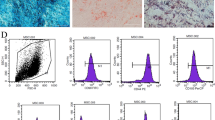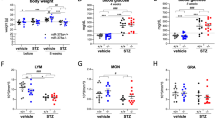Abstract
Purpose
The extent of myocardial fibrosis is closely related to the prognosis of diabetic cardiomyopathy (DCM). Low-intensity pulsed ultrasound (LIPUS) has been reported to have multiple biological effects. However, the effect of LIPUS on diabetic heart fibrosis remains unclear. The present study aimed to investigate the effect of LIPUS on diabetic heart fibrosis and explore its underlying mechanisms.
Methods and Results
High glucose (HG) was applied to cultured neonatal rat cardiac fibroblasts (NRCFs) to mimic the in vivo hyperglycemia microenvironment. LIPUS (19.30 mW/cm2 to 77.20 mW/cm2) dose-dependently inhibited HG-induced fibrotic response in NRCFs. Also, LIPUS downregulated NADPH oxidase 4 (NOX4)-associated oxidative stress and nod-like receptor protein-3 (NLRP3) inflammasome activation in NRCFs. In vivo, diabetes in mice was induced with streptozotocin (STZ). Mice in the LIPUS group and STZ + LIPUS group were treated with LIPUS (77.20 mW/cm2) twice a week for 12 weeks and then euthanized at 12 weeks or 24 weeks post-diabetes. Treatment with LIPUS significantly ameliorated the progression of cardiac fibrosis (Masson staining 6.5 ± 2.3% vs. 2.8 ± 1.5%, P < 0.001) and dysfunction (E/A ratio 1.35 ± 0.14 vs. 1.59 ± 0.11, P < 0.05), as well as NOX4-associated oxidative stress (relative expression fold of NOX4 1.43 ± 0.12 vs. 1.07 ± 0.10, P < 0.01; relative DHE fluorescence 1.51 ± 0.13 vs. 1.28 ± 0.06, P < 0.05) and NLRP3 inflammasome activation (relative expression fold of NLRP3 1.57 ± 0.12 vs. 1.05 ± 0.16, P < 0.01), at 12 weeks post-diabetes. At 24 weeks post-diabetes, the heart function in diabetic mice treated with LIPUS was still significantly better than untreated diabetic mice (E/A ratio 1.08 ± 0.12 vs. 1.49 ± 0.14, P < 0.001). Further exploration revealed that LIPUS significantly attenuated the upregulated angiotensin-converting enzyme (ACE) and angiotensin II (AngII), in both HG-induced NRCFs and diabetic hearts (relative expression of ACE in myocardium 3.77 ± 0.55 vs. 1.07 ± 0.13, P < 0.001; AngII in myocardium 115.5 ± 21.77 ng/ml vs. 84.28 ± 9.03 ng/ml, P < 0.01). Captopril, an ACE inhibitor, inhibited NOX4-associated oxidative stress and NLRP3 inflammasome activation in both HG-induced NRCFs and diabetic hearts.
Conclusion
Our results indicate that non-invasive local LIPUS therapy attenuated heart fibrosis and dysfunction in diabetic mice and the effect could be largely preserved at least 12 weeks after suspending LIPUS stimulation. LIPUS ameliorated diabetic heart fibrosis by inhibiting ACE-mediated NOX4-associated oxidative stress and NLRP3 inflammasome activation in cardiac fibroblasts. Our study may provide a novel therapeutic approach to hamper the progression of diabetic heart fibrosis.






Similar content being viewed by others
Data Availability
All data included in this study are available upon request from the corresponding author.
References
Borghetti G, von Lewinski D, Eaton DM, et al. Diabetic cardiomyopathy: current and future therapies, Beyond glycemic control. Front Physiol. 2018;9:1514.
Ritchie RH, Abel ED. Basic mechanisms of diabetic heart disease. Circ Res. 2020;126(11):1501–25.
Tate M, Grieve DJ, Ritchie RH. Are targeted therapies for diabetic cardiomyopathy on the horizon? Clin Sci (Lond). 2017;131(10):897–915.
Patil VC, Patil HV, Shah KB, Vasani JD, Shetty P. Diastolic dysfunction in asymptomatic type 2 diabetes mellitus with normal systolic function. J Cardiovasc Dis Res. 2011;2(4):213–22.
Jia G, Hill MA, Sowers JR. Diabetic cardiomyopathy: an update of mechanisms contributing to this clinical entity. Circ Res. 2018;122(4):624–38.
Tuleta I, Frangogiannis NG. Diabetic fibrosis. Biochim Biophys Acta Mol basis Dis. 1867;2021(4):166044.
Russo I, Frangogiannis NG. Diabetes-associated cardiac fibrosis: cellular effectors, molecular mechanisms and therapeutic opportunities. J Mol Cell Cardiol. 2016;90:84–93.
Levick SP, Widiapradja A. The diabetic cardiac fibroblast: mechanisms underlying phenotype and function. Int J Mol Sci. 2020;21(3):970.
Li Y, Li Z, Zhang C, et al. Cardiac fibroblast-specific activating transcription factor 3 protects against heart failure by suppressing MAP2K3-p38 signaling. Circulation. 2017;135(21):2041–57.
Piccoli MT, Gupta SK, Viereck J, et al. Inhibition of the cardiac fibroblast-enriched lncRNA Meg3 prevents cardiac fibrosis and diastolic dysfunction. Circ Res. 2017;121(5):575–83.
Souders CA, Bowers SL, Baudino TA. Cardiac fibroblast: the renaissance cell. Circ Res. 2009;105(12):1164–76.
Harrison A, Lin S, Pounder N, Mikuni-Takagaki Y. Mode & mechanism of low intensity pulsed ultrasound (LIPUS) in fracture repair. Ultrasonics. 2016;70:45–52.
Nolte P, Anderson R, Strauss E, et al. Heal rate of metatarsal fractures: a propensity-matching study of patients treated with low-intensity pulsed ultrasound (LIPUS) vs. surgical and other treatments. Injury. 2016;47(11):2584–90.
Zhou XY, Xu XM, Wu SY, et al. Low-intensity pulsed ultrasound promotes spinal fusion and enhances migration and proliferation of MG63s through sonic hedgehog signaling pathway. Bone. 2018;110:47–57.
Nakao J, Fujii Y, Kusuyama J, et al. Low-intensity pulsed ultrasound (LIPUS) inhibits LPS-induced inflammatory responses of osteoblasts through TLR4-MyD88 dissociation. Bone. 2014;58:17–25.
Chung JI, Barua S, Choi BH, et al. Anti-inflammatory effect of low intensity ultrasound (LIUS) on complete Freund's adjuvant-induced arthritis synovium. Osteoarthr Cartil. 2012;20(4):314–22.
Shindo T, Ito K, Ogata T, et al. Low-intensity pulsed ultrasound enhances angiogenesis and ameliorates left ventricular dysfunction in a mouse model of acute myocardial infarction. Arterioscler Thromb Vasc Biol. 2016;36(6):1220–9.
Zhang X, Fu Y, Li H, et al. H3 relaxin inhibits the collagen synthesis via ROS- and P2X7R-mediated NLRP3 inflammasome activation in cardiac fibroblasts under high glucose. J Cell Mol Med. 2018;22(3):1816–25.
Furman BL. Streptozotocin-induced diabetic models in mice and rats. Curr Protoc. 2021;1(4):e78.
Zhao K, Weng L, Xu T, et al. Low-intensity pulsed ultrasound prevents prolonged hypoxia-induced cardiac fibrosis through HIF-1alpha/DNMT3a pathway via a TRAAK-dependent manner. Clin Exp Pharmacol Physiol. 2021;48(11):1500–1514.
Singh VP, Baker KM, Kumar R. Activation of the intracellular renin-angiotensin system in cardiac fibroblasts by high glucose: role in extracellular matrix production. Am J Physiol Heart Circ Physiol. 2008;294(4):H1675–84.
Kumar R, Yong QC, Thomas CM, Baker KM. Intracardiac intracellular angiotensin system in diabetes. Am J Physiol Regul Integr Comp Physiol. 2012;302(5):R510–7.
Kuroda J, Ago T, Matsushima S, et al. NADPH oxidase 4 (Nox4) is a major source of oxidative stress in the failing heart. Proc Natl Acad Sci U S A. 2010;107(35):15565–70.
McGavock JM, Lingvay I, Zib I, et al. Cardiac steatosis in diabetes mellitus: a 1H-magnetic resonance spectroscopy study. Circulation. 2007;116(10):1170–5.
Levelt E, Gulsin G, Neubauer S, McCann GP. MECHANISMS IN ENDOCRINOLOGY: diabetic cardiomyopathy: pathophysiology and potential metabolic interventions state of the art review. Eur J Endocrinol. 2018;178(4):R127–39.
Holscher ME, Bode C, Bugger H. Diabetic cardiomyopathy: does the type of diabetes matter? Int J Mol Sci. 2016;17(12):2136.
Singh VP, Le B, Bhat VB, Baker KM, Kumar R. High-glucose-induced regulation of intracellular ANG II synthesis and nuclear redistribution in cardiac myocytes. Am J Physiol Heart Circ Physiol. 2007;293(2):H939–48.
Investigators O, Yusuf S, Teo KK, et al. Telmisartan, ramipril, or both in patients at high risk for vascular events. N Engl J Med. 2008;358(15):1547–59.
Faria A, Persaud SJ. Cardiac oxidative stress in diabetes: mechanisms and therapeutic potential. Pharmacol Ther. 2017;172:50–62.
van der Pol A, van Gilst WH, Voors AA, van der Meer P. Treating oxidative stress in heart failure: past, present and future. Eur J Heart Fail. 2019;21(4):425–35.
Chan EC, Peshavariya HM, Liu GS, et al. Nox4 modulates collagen production stimulated by transforming growth factor beta1 in vivo and in vitro. Biochem Biophys Res Commun. 2013;430(3):918–25.
Liu XH, Pan LL, Deng HY, et al. Leonurine (SCM-198) attenuates myocardial fibrotic response via inhibition of NADPH oxidase 4. Free Radic Biol Med. 2013;54:93–104.
Cucoranu I, Clempus R, Dikalova A, et al. NAD(P)H oxidase 4 mediates transforming growth factor-beta1-induced differentiation of cardiac fibroblasts into myofibroblasts. Circ Res. 2005;97(9):900–7.
Farooq MA, Gaertner S, Amoura L, et al. Intake of omega-3 formulation EPA:DHA 6:1 by old rats for 2 weeks improved endothelium-dependent relaxations and normalized the expression level of ACE/AT1R/NADPH oxidase and the formation of ROS in the mesenteric artery. Biochem Pharmacol. 2020;173:113749.
Li XX, Ling SK, Hu MY, et al. Protective effects of acarbose against vascular endothelial dysfunction through inhibiting Nox4/NLRP3 inflammasome pathway in diabetic rats. Free Radic Biol Med. 2019;145:175–86.
Yang Y, Wang H, Kouadir M, Song H, Shi F. Recent advances in the mechanisms of NLRP3 inflammasome activation and its inhibitors. Cell Death Dis. 2019;10(2):128.
Funding
This manuscript was supported by the National Natural Science Foundation of China (No. 81627802), and a Postdoctoral Research Funding Plan of Jiangsu Province [JX1021123202021]; and a Nanjing Medical University Postdoctoral Fund [JX1021121201914].
Author information
Authors and Affiliations
Contributions
Animal experiment: LQW, LL and KZ; Cell experiment: LQW, LL and KZ; Echocardiography: JW; Biochemical experiment: YKM, HYS, XGC and JC; LIPUS system maintenance: XSG, JT and DZ; Data analysis: YKM and HYS; Project administration: LQW and THX; Supervision: WS and XQK; Manuscript writing: LQW; Manuscript revision: WS and XQK.
Corresponding authors
Ethics declarations
Conflict of Interest
The authors state that there is no conflict of interest.
Ethical Approval
This article does not contain any studies with human participants performed by any of the authors.
Informed Consent
This article does not contain any studies with human participants performed by any of the authors.
Additional information
Publisher’s Note
Springer Nature remains neutral with regard to jurisdictional claims in published maps and institutional affiliations.
Rights and permissions
About this article
Cite this article
Weng, L., Li, L., Zhao, K. et al. Non-Invasive Local Acoustic Therapy Ameliorates Diabetic Heart Fibrosis by Suppressing ACE-Mediated Oxidative Stress and Inflammation in Cardiac Fibroblasts. Cardiovasc Drugs Ther 36, 413–424 (2022). https://doi.org/10.1007/s10557-021-07297-6
Accepted:
Published:
Issue Date:
DOI: https://doi.org/10.1007/s10557-021-07297-6




